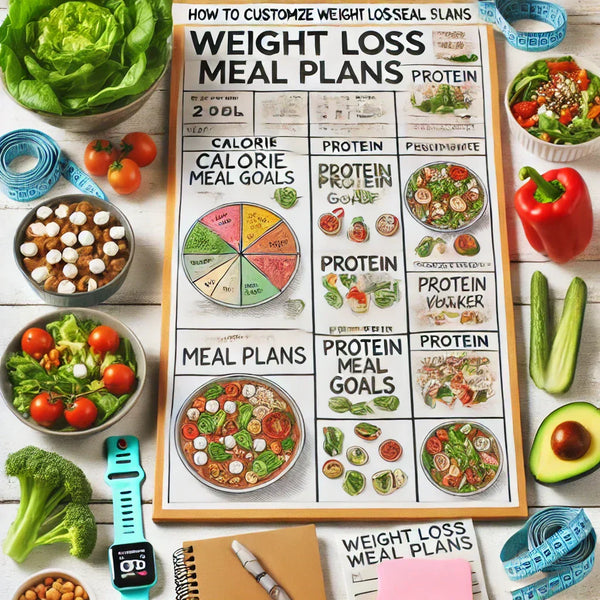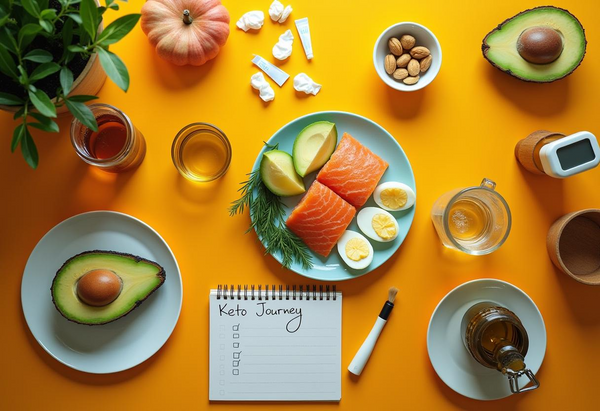Dirty Keto vs. Clean Keto - Here's the RIGHT way to go on a keto diet!
by Elloww Team

Introduction
The ketogenic (keto) diet has taken the health and wellness world by storm especially among individuals looking to manage weight, stabilize blood sugar, or improve energy levels. Originally developed to treat epilepsy, keto is now widely adopted for its ability to shift the body into a state of ketosis, where fat becomes the primary fuel source instead of carbohydrates. This metabolic shift can be particularly beneficial for people managing type 2 diabetes, as it may help improve insulin sensitivity and regulate glucose levels more effectively than traditional diets.
However, not all keto diets are created equal. As the trend has evolved, two distinct paths have emerged: clean keto and dirty keto. While both approaches focus on low-carb, high-fat principles, they differ significantly in food quality and long-term impact on health.
In this blog, we’ll break down the key differences between clean and dirty keto, highlight the pros and cons of each, and help you make an informed choice about which path aligns best with your health goals especially if you're aiming for sustainable results and better metabolic health.
What is Clean Keto?
Clean keto is a nutrient-dense approach to the ketogenic diet that emphasizes the quality of food just as much as the macronutrient breakdown. While the foundational principle of keto keeping carbohydrates low and fats high remains the same, clean keto takes a more health-conscious route by focusing on whole, unprocessed foods.
This version of keto encourages the consumption of high-quality fats such as avocado, olive oil, nuts, seeds, and fatty fish like salmon or mackerel. Instead of relying on processed meats or artificial ingredients, clean keto prioritizes grass-fed meats, pasture-raised poultry, cage-free eggs, and organic dairy. The diet also includes a variety of low-carb vegetables such as spinach, kale, zucchini, and broccoli, which supply fiber, antioxidants, and essential vitamins and minerals.
Clean keto avoids processed or packaged "keto-friendly" foods that may be technically low in carbs but high in inflammatory oils, additives, or artificial sweeteners. The focus is on real, whole ingredients that nourish the body and support long-term wellness.
By sticking to nutrient-rich, minimally processed foods, clean keto supports better gut health, reduced inflammation, improved metabolic function, and more stable energy levels. For individuals managing type 2 diabetes, this approach may also contribute to more consistent blood sugar control and a reduced risk of complications.
Overall, clean keto is not just a diet, it's a lifestyle shift that combines the metabolic benefits of ketosis with the overall health advantages of clean eating.
The Benefits of Clean Keto
Clean keto offers a powerful combination of metabolic efficiency and nutritional quality, making it especially beneficial for those managing type 2 diabetes or seeking sustainable long-term health improvements.
One of the most recognized benefits is sustainable weight loss. Unlike typical calorie-restricted diets, clean keto promotes satiety through healthy fats and fiber-rich vegetables, helping individuals naturally reduce calorie intake without feeling deprived. A 2020 study published in Nutrition & Metabolism found that participants following a well-formulated ketogenic diet experienced greater fat loss and preserved lean mass compared to those on a low-fat diet.
Blood sugar control is another key advantage. Clean keto minimizes blood sugar spikes by eliminating refined carbohydrates and sugars, replacing them with nutrient-dense, low-glycemic foods. Research in Diabetes Therapy (2018) showed that individuals with type 2 diabetes on a ketogenic diet significantly reduced HbA1c levels and, in some cases, were able to decrease or eliminate diabetes medications.
Beyond metabolic benefits, clean keto also enhances nutrient intake. By prioritizing whole foods, individuals consume more essential vitamins, minerals, antioxidants, and omega-3 fatty acids, which support immune health, reduce inflammation, and promote better cognitive function. In contrast to dirty keto, which may meet macronutrient targets but fall short on micronutrients, clean keto ensures the body is nourished at every level.
Clean Keto vs. Dirty Keto
While both clean and dirty keto aim to keep the body in ketosis by limiting carbs and increasing fat intake, the quality of the food sources is what sets them apart.
Clean keto emphasizes whole, nutrient-dense foods like avocados, leafy greens, nuts, seeds, and grass-fed meats. In contrast, dirty keto allows for highly processed, low-carb items like bacon, cheese slices, fast-food patties, and artificial sweeteners—as long as they meet the keto macros.
Here's a quick comparison:
Aspect
Food Quality
Clean Keto: Whole, unprocessed foods
Dirty Keto: Processed, packaged, and fast foods
Fat Sources
Clean Keto: Avocados, olive oil, nuts
Dirty Keto: Processed meats, seed oils, trans fats
Nutrient Density
Clean Keto: High in vitamins, minerals, and fiber
Dirty Keto: Often low in micronutrients
Health Focus
Clean Keto: Supports overall well-being and longevity
Dirty Keto: Focused only on carb restriction
What is Dirty Keto?
Dirty keto is a variation of the ketogenic diet that focuses solely on maintaining low carbohydrate intake and high fat consumption—without prioritizing the quality of food sources. As long as the macronutrient ratio fits the keto framework (typically 70–75% fats, 20–25% protein, and 5–10% carbs), almost any food is acceptable—even if it's highly processed.
This version of keto often includes items like fast-food burgers (minus the bun), processed cheese slices, pork rinds, low-carb protein bars, and artificially sweetened beverages. The appeal of dirty keto lies in its convenience it's quick, easy to follow, and doesn’t require cooking or planning.
However, dirty keto sacrifices nutrient quality for ease and speed. While it may lead to rapid weight loss and help maintain ketosis, it lacks essential vitamins, minerals, fiber, and antioxidants that are typically found in whole foods. Over time, a reliance on processed and refined items can lead to digestive issues, inflammation, nutrient deficiencies, and increased risk of heart disease.
Dirty keto may appear effective on the surface, especially for short-term goals, but it fails to support long-term health, especially for individuals with type 2 diabetes who need stable blood sugar, heart health, and balanced nutrition. Choosing quality over quantity is key for sustainable well-being.
The Risks of Dirty Keto
While dirty keto may seem like an easy route to enter ketosis, it comes with significant health risks, especially for individuals managing type 2 diabetes or aiming for long-term wellness. The heavy reliance on processed, low-nutrient foods makes this approach problematic.
One major concern is nutrient deficiency. Dirty keto often lacks fiber, essential vitamins (like B-complex, vitamin C), minerals (such as magnesium and potassium), and antioxidants. These are vital for energy metabolism, immune function, and cardiovascular health. A diet dominated by processed meats, refined oils, and artificial sweeteners can leave your body undernourished despite meeting macronutrient goals.
Another risk is the increased potential for chronic diseases. Processed foods commonly found in dirty keto—such as bacon, sausage, processed cheese, packaged low-carb snacks, and artificially sweetened drinks—are often high in sodium, trans fats, preservatives, and additives. Over time, this can raise the risk of high blood pressure, insulin resistance, heart disease, and even certain cancers.
Moreover, artificial ingredients used to replace carbs in dirty keto products may disrupt gut health and metabolism, and in some cases, trigger insulin spikes, which can hinder ketosis and affect blood sugar regulation.
The Core Principles of Clean Keto Foods
The clean keto approach is built around principles that prioritize nutritional quality while still maintaining the low-carb, high-fat framework of the ketogenic diet. These principles help ensure that your body achieves and maintains ketosis, but in a way that also supports long-term health and metabolic balance—especially for individuals managing type 2 diabetes or other chronic conditions.
1. Low Carbs (Under 50g per Day)
The foundation of any keto diet is keeping carbohydrate intake low—typically below 50 grams per day. This restriction forces the body to shift from burning glucose for energy to burning fat, producing ketones as an alternative fuel source. For people with type 2 diabetes, maintaining ketosis can help regulate blood sugar levels, improve insulin sensitivity, and reduce dependency on medications. However, clean keto focuses on low-carb vegetables like spinach, kale, zucchini, and broccoli instead of processed low-carb alternatives.
2. High-Quality Fats
Clean keto emphasizes fats that come from natural, anti-inflammatory sources. This includes avocados, nuts and seeds, extra virgin olive oil, coconut oil, fatty fish (like salmon, sardines, and mackerel), and pasture-raised eggs. These fats not only help maintain ketosis but also provide essential omega-3 and omega-9 fatty acids, which are crucial for heart health, brain function, and reducing systemic inflammation.
3. Whole, Unprocessed Foods
A key difference between clean and dirty keto lies in the quality of ingredients. Clean keto avoids highly processed or artificially sweetened products in favor of whole, nutrient-dense foods. This means eating non-starchy vegetables, organic meats, bone broth, herbs, spices, and fermented foods. These choices ensure a more balanced nutrient profile, support gut health, and help prevent the nutrient deficiencies often seen in conventional ketogenic diets.
By following these clean keto principles, individuals can enjoy the benefits of ketosis while promoting overall well-being and reducing the risks often associated with poorly planned keto diets.
Best Clean Keto Foods to Include in Your Diet
Choosing the right foods is essential for success on a clean keto diet, especially when the goal is not just to stay in ketosis but to support overall health, including blood sugar stability, nutrient density, and anti-inflammatory benefits. Below is a breakdown of the best food groups and examples to include in a clean keto
meal plan:
1. Healthy Fats
Fats are the core of any ketogenic diet, but clean keto prioritizes quality over quantity. Opt for fats that are rich in monounsaturated and polyunsaturated fatty acids, which support heart health and reduce inflammation.
- Avocados – Loaded with fiber and heart-healthy fats
- Olive Oil – A staple for salad dressings and light cooking
- Coconut Oil – Great for cooking and contains MCTs for quick energy
- Grass-Fed Butter or Ghee – Nutrient-rich and contains CLA (conjugated linoleic acid)
- Fatty Fish – Like salmon, sardines, and mackerel, high in omega-3s
2. Protein Sources
Protein intake on clean keto focuses on moderation and quality, avoiding heavily processed meats.
- Grass-Fed Beef – Higher in nutrients and omega-3s than grain-fed beef
- Free-Range Poultry – Better animal welfare and cleaner protein
- Pasture-Raised Eggs – Nutrient-dense and rich in healthy fats
- Wild-Caught Fish – Less likely to contain toxins and more nutrient-rich
3. Low-Carb Vegetables
These provide essential vitamins, minerals, antioxidants, and fiber without kicking you out of ketosis.
- Spinach, Kale, and Swiss Chard – Great for micronutrient support
- Zucchini and Mushrooms – Low in carbs, high in versatility
- Broccoli and Cauliflower – Crucial for fiber and gut health
4. Nuts and Seeds
These provide healthy fats, protein, and fiber—perfect for snacking or adding to meals.
- Almonds, Walnuts, Pecans
- Chia Seeds and Flaxseeds – High in omega-3s and fiber
5. Dairy (if tolerated)
Some individuals do well with full-fat dairy, which provides both fat and protein.
- Full-Fat Cheese – A satiating source of calcium and fat
- Greek Yogurt – Choose unsweetened, plain varieties
- Heavy Cream – Ideal for coffee or creamy recipes
This food foundation ensures that your clean keto diet remains nutrient-dense, sustainable, and health-supportive in the long run.
How to Incorporate Clean Keto Foods into Your Meals
Following a clean keto lifestyle becomes easier and more sustainable when you build smart habits around meal preparation and planning. With a little organization, you can enjoy nutrient-dense meals without the stress of daily cooking or the temptation of processed convenience foods.
Meal Prep Tips for Clean Keto Success
Batch Cook Proteins: Grill or bake several servings of grass-fed beef, chicken, or wild-caught fish at once. Store in airtight containers for quick meal assembly throughout the week.
Pre-Chop Vegetables: Wash and chop low-carb vegetables like kale, zucchini, mushrooms, and broccoli in advance to save time and increase your chances of making healthier choices.
Smart Snacking: Portion out keto-friendly snacks such as almonds, boiled eggs, or sliced cheese for quick grab-and-go options when cravings hit.
Sample Clean Keto Meals
Incorporate variety and balance into your clean keto diet with these simple meal ideas:
Breakfast: Scrambled pasture-raised eggs with avocado slices and sautéed spinach
Lunch: Grilled chicken breast over a kale salad with olive oil and lemon dressing
Dinner: Oven-baked salmon with cauliflower mash and steamed broccoli
Snack: A handful of raw almonds paired with a few cubes of full-fat cheese
By keeping clean keto staples on hand and preparing meals ahead of time, you'll find it easier to stay consistent, avoid processed foods, and maximize the health benefits of your keto journey.
Why Choose Clean Keto for Long-Term Success?
Clean keto offers a sustainable approach to long-term health, weight management, and overall well-being by focusing on whole, nutrient-dense foods. Unlike dirty keto, which often relies on processed foods, clean keto prioritizes high-quality fats, lean proteins, and low-carb vegetables, ensuring that your body gets the right nutrients for optimal functioning.
This balanced approach not only supports weight loss but also helps maintain stable blood sugar levels, making it especially beneficial for individuals managing conditions like type 2 diabetes. The rich supply of antioxidants and anti-inflammatory compounds from whole foods helps prevent nutrient deficiencies and promotes overall health.
Moreover, clean keto is linked to heart health through the consumption of healthy fats such as avocado, olive oil, and fatty fish, which contribute to better cholesterol levels. Additionally, clean keto supports mental clarity and brain function, as the body uses ketones
Conclusion
Choosing clean keto is a smart, sustainable approach for long-term health and well-being. By focusing on whole, unprocessed foods and healthy fats, clean keto supports not only weight management but also stable blood sugar levels, heart health, and mental clarity. Unlike dirty keto, which often relies on processed foods, clean keto ensures your body receives the essential nutrients it needs to thrive.
Incorporating clean keto foods into your daily meals can be a transformative step toward a healthier lifestyle. Whether you’re aiming for sustained weight loss or simply a more balanced diet, clean keto offers a nutrient-rich and effective path to achieving your health goals. Embrace clean keto for long-term success, and give your body the nutrition it truly deserves.




